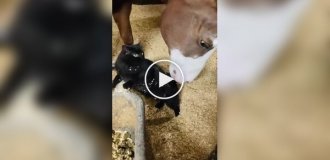An interesting way to grow potatoes when planting space is limited.
To do this, take a tall container - iron, plastic, wood - it doesn’t matter what, the main thing is that it is without a bottom and with holes made around the circumference so that the soil has the opportunity to breathe and water does not stagnate at the bottom.
This method has a long history. Once a peasant, preparing compost in an old barrel, dropped a potato tuber into it, which sprouted after a while. The stems were again covered with another portion of waste. When the container was full, a potato bush grew on it.
In the fall, the peasant decided to pull it out, but that was not the case. The stems went deep into the compost and were covered with garlands of tubers. He ended up collecting about a bag of potatoes.

Gradually this method was improved. At first they made do with one tuber. It was placed at the bottom of the container, lined with a layer of compost 5-6 cm thick and 9-10 cm of compost sprinkled on top. When the seedlings reached 2-3 cm, they were sprinkled again in the same way. And this was repeated several times. By the end of the growing season, there were already many tubers of various sizes in the barrel.
Later they began to arrange the tubers in a checkerboard pattern. When the shoots appeared, they were covered with the same layer of compost and tubers were planted on top again. This operation was repeated 4-5 times, the plants were hilled up as necessary. The harvest was harvested gradually, starting from the last planting date.

Potatoes are planted (since they do not form stepsons) approximately every 20 cm, and if the growing container is round in cross-section, we plant it along the diameter, but if it is square, in a checkerboard pattern.

There will be a lot of tubers planted, so the holes made in the sides of the barrel are clearly not enough to supply oxygen to the root system of all plants. To avoid oxygen starvation in the root zone, it is necessary to lay a rubber hose at the bottom of the barrel, coiled in a spiral so that the distance between the turns is about 10 cm. Make slit-like cuts in the hose every 15-20 cm with a knife, 2-3 cm long. The outer end lead the hose outside the barrel, and plug the inner hose tightly. This is done in order to pump air into the root zone 2-3 times a week for 5-10 minutes with an ordinary pump.

When filling the barrel with soil mixture layer by layer, do not allow the sprouts to hatch completely. As soon as the sprout reaches the upper boundary of the soil layer, it is necessary to immediately fill in the next layer. If you miss this process, the sprouts will completely germinate, form the green part, and the plant will no longer form a root system, but a powerful green stem will develop all the way to the surface of the earth.
If, due to circumstances, you are not able to monitor the formation of sprouts, then you can sequentially plant potatoes in each of the three lower layers of the soil mixture, not necessarily with whole tubers, but in order to save planting material, use parts of a tuber or eyes. This will give you a 3-story landing. And if you do everything correctly, then many powerful tube-shaped root systems will form in the barrel, on which a huge number of tubers will form.
Don't forget to maintain the required soil moisture. Also keep in mind that by about mid-July your potatoes will have “eaten up” almost all the nutrients in the barrel, so the plants will require additional feeding. And since you cannot add fresh “EM-bokashi”, because the barrel is already full, you can water the plant with a mash made from them. This procedure should be carried out at least once a week, but it is better, of course, 2-3 times, if you have such an opportunity.
To prepare mash it is necessary, for example, to fill a 200-liter barrel one third with a soil mixture of diluted EM-1 and turf soil in a 1:1 ratio, top up with non-chlorinated water and let it brew for at least a day. For example, you arrive at the site on Saturday evening, immediately ferment the mash, and on Sunday evening, before leaving, water your plants.
By observing all the conditions listed above, as well as pumping air into the root system, you can get more than a bag of potatoes from a 1x1 m plot.






















